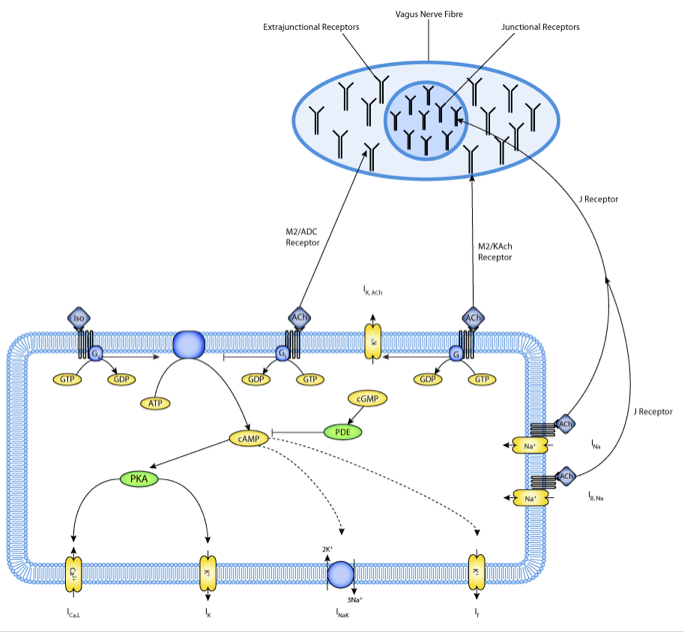Single Cell action potential of rabbit sinoatrial node modulated by acetyl choline by Demir, Clark, Giles 1999 from CellML source
Description

NOTA BENE: The model parameter and variable units were revised so that the model could be compiled with "unit conversion on;" (ABSTRACT) We have extended our compartmental model [Am. J. Physiol. 266 (Cell Physiol. 35): C832–C852, 1994] of the single rabbit sinoatrial node (SAN) cell so that it can simulate cellular responses to bath applications of ACh and isoprenaline as well as the effects of neuronally released ACh. The model employs three different types of muscarinic receptors to explain the variety of responses observed in mammalian cardiac pacemaking cells subjected to vagal stimulation. The response of greatest interest is the ACh-sensitive change in cycle length that is not accompanied by a change in action potential duration or repolarization or hyperpolarization of the maximum diastolic potential. In this case, an AChsensitiveK ! current is not involved.Membrane hyperpolarization occurs in response to much higher levels of vagal stimulation, and this response is also mimicked by the model. Here, an ACh-sensitive K+ current is involved. The wellknown phase-resetting response of the SAN cell to single and periodically applied vagal bursts of impulses is also simulated in the presence and absence of the "beta-agonist isoprenaline. Finally, the responses of the SAN cell to longer continuous trains of periodic vagal stimulation are simulated, and this can result in the complete cessation of pacemaking. Therefore, thismodel is 1) applicable over the full range of intensity and pattern of vagal input and 2) can offer biophysically based explanations for many of the phenomena associated with the autonomic control of cardiac pacemaking.
Equations
The equations for this model may be viewed by running the JSim model applet and clicking on the Source tab at the bottom left of JSim's Run Time graphical user interface. The equations are written in JSim's Mathematical Modeling Language (MML). See the Introduction to MML and the MML Reference Manual. Additional documentation for MML can be found by using the search option at the Physiome home page.
- Download JSim model MML code (text):
- Download translated SBML version of model (if available):
We welcome comments and feedback for this model. Please use the button below to send comments:
Please cite https://www.imagwiki.nibib.nih.gov/physiome in any publication for which this software is used and send one reprint to the address given below:
The National Simulation Resource, Director J. B. Bassingthwaighte, Department of Bioengineering, University of Washington, Seattle WA 98195-5061.
Model development and archiving support at https://www.imagwiki.nibib.nih.gov/physiome provided by the following grants: NIH U01HL122199 Analyzing the Cardiac Power Grid, 09/15/2015 - 05/31/2020, NIH/NIBIB BE08407 Software Integration, JSim and SBW 6/1/09-5/31/13; NIH/NHLBI T15 HL88516-01 Modeling for Heart, Lung and Blood: From Cell to Organ, 4/1/07-3/31/11; NSF BES-0506477 Adaptive Multi-Scale Model Simulation, 8/15/05-7/31/08; NIH/NHLBI R01 HL073598 Core 3: 3D Imaging and Computer Modeling of the Respiratory Tract, 9/1/04-8/31/09; as well as prior support from NIH/NCRR P41 RR01243 Simulation Resource in Circulatory Mass Transport and Exchange, 12/1/1980-11/30/01 and NIH/NIBIB R01 EB001973 JSim: A Simulation Analysis Platform, 3/1/02-2/28/07.

